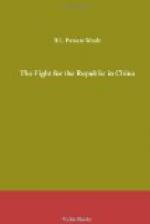The Manchu people, who belong to the Mongol or Turanian Group, number at the maximum five million souls. Their distribution at the time of the revolution of 1911 was roughly as follows: In and around Peking say two millions, in posts through China say one-half million,—or possibly three-quarters of a million; in Manchuria Proper—the home of the race—say two or two and a half millions. The fighting force was composed in this fashion: When Peking fell into their hands in 1644 as a result of a stratagem combined with dissensions among the Chinese themselves, the entire armed strength was re-organized in Eight Banners or Army Corps, each corps being composed of three racial divisions, (1) pure Manchus, (2) Mongols who had assisted in the conquest and (3) Nothern Chinese who had gone over to the conquerors. These Eight Banners, each commanded by an “iron-capped” Prince, represented the authority of the Throne and had their headquarters in Peking with small garrisons throughout the provinces at various strategic centres. These garrisons had entirely ceased to have any value before the 18th Century had closed and were therefore pure ceremonial and symbolic, all the fighting being done by special Chinese corps which were raised as neccessity arose.]
The history of the Nineteenth Century is thus logically enough the history of successive collapses. Not only did overseas foreigners openly thunder at the gateways of the empire and force an ingress, but native rebellions were constant and common. Leaving minor disturbances out of account, there were during this period two huge Mahommedan rebellions, besides the cataclysmic Taiping rising which lasted ten years and is supposed to have destroyed the unbelievable total of one hundred million persons. The empire, torn by internecine warfare, surrendered many of its essential prerogatives to foreigners, and by accepting the principle of extraterritoriality prepared the road to ultimate collapse.
How in such circumstances was it possible to keep alive absolutism? The answer is so curious that we must be explicit and exhaustive.
The simple truth is that save during the period of vigour immediately following each foreign conquest (such as the Mongol conquest in the Thirteenth Century and the Manchu in the Seventeenth) not only has there never been any absolutism properly so-called in China, but that apart from the most meagre and inefficient tax-collecting and some rough-and-ready policing in and around the cities there has never been any true governing at all save what the people did for themselves or what they demanded of the officials as a protection against one another. Any one who doubts these statements has no inkling of those facts which are the crown as well as the foundation of the Chinese group-system, and which must be patiently studied in the village-life of the country to be fitly appreciated. To be quite frank, absolutism is a myth coming down from the days of Kublai Khan when he so proudly built




